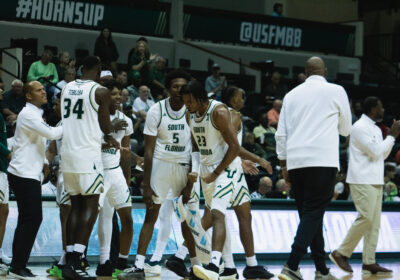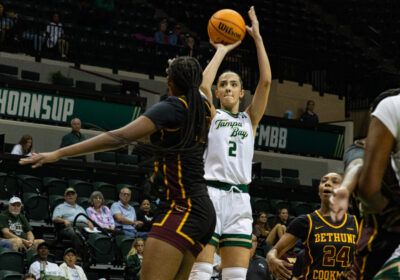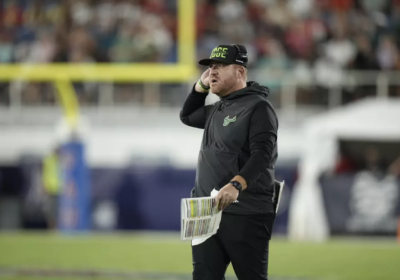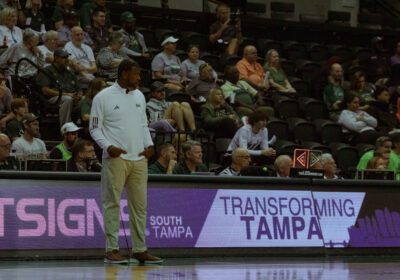USF to play Syracuse in Boca Raton Bowl. Here’s what that means.

USF football is set to face Syracuse in the Boca Raton Bowl on Dec. 21.
It’s the first time the Bulls (6-6, 4-4 AAC) will play the Orange (6-6, 2-6 ACC) in seven years.
Syracuse started its season winning six straight but only won two games in Atlantic Coast conference play. It fired head coach Dino Babers in November.
The Orange clinched bowl eligibility with a 35-31 win over Wake Forest in their final regular season game.
The last matchup between the two teams was on Sept. 17, 2016, and resulted in a 45-20 win for USF.
USF has appeared in 10 bowl games, compiling a 6-4 record in postseason play. Its recent bowl streak lasted from 2015 to its latest appearance in the 2018 Gasparilla Bowl.
Related: USF ends five-year bowl drought with 48-14 win over Charlotte
While the Bulls have snapped their bowl appearance drought, they will have an opportunity to break another streak – beating a Power Five opponent.
USF has not won against a Power Five team since beating Illinois 25-19 in 2018.
How do bowl games work?
A postseason bid is reserved for FBS teams that finish with six wins or more. There are 43 bowl games slated for this season, with this year’s Rose Bowl and Sugar Bowl serving as the College Football Playoff games.
The bowl matchup will serve as the 13th and final game of the season, no matter if the Bulls win or lose.
Bowl games are almost exclusively comprised of inter-conference matchups, meaning that each team is playing from a different conference. This gives teams that otherwise would rarely play each other a chance to meet on the field.
How does bowl eligibility impact USF Football?
Bowl games are important for developing collegiate programs – one of the benefits of a postseason is that they allow teams to gain more practice time.
The NCAA places strict limits on how often teams are allowed to practice. Bowl-eligible teams, like USF, are given more permissible practice time. The Bulls can practice 20 hours a week until the day of the Bowl game.
Student-athletes on non-bowl-eligible teams are only allowed to practice eight hours per week of required athletic activities during that time span.
Bulls coach Alex Golesh said in a Sunday press conference that the extra practice is one of the primary reasons he is looking forward to the bowl game.
He said the additional practices allow for players’ that don’t see much playing time to further develop.
“It’s absolutely priceless,” Golesh said. “Some of these guys that you really haven’t been able to see, they’ve practiced, but not to the degree we’ve been able to coach them the last two days.”
Related: ‘You have to go through the hard’: Takeaways from USF’s bowl-clinching win against Charlotte
How much revenue could the university make?
Universities also financially benefit from bowl-eligible football programs. USF will receive $300,000 from the NCAA for merely participating in a postseason game, according to the College Football Playoff Revenue Distribution Plan for the 2023-24 postseason.
Golesh will receive a $25,000 bonus for making the postseason, and $50,000 if the team wins the game.
Related: Golesh’s salary similar to Scott’s
The American Conference will also receive $4 million for every team that plays in a non-playoff bowl, according to the distribution plan.
Individual bowl games also offer hefty payouts for the winning team. Last season, Wake Forest received over $1.1 million in stipulations for defeating Missouri in the Gasparilla Bowl, according to the distribution plan.
How many viewers could watch the game?
Bowl games are also almost exclusively broadcast on major networks, garnering a large amount of viewership and national attention. In 2018, USF racked up over 1.7 million viewers for its game against Marshall in the Gasparilla Bowl, which was broadcast on ESPN.
USF only garnered 17,000 viewers during its last game against Charlotte on Nov. 25.
The 10 most-viewed non-New Year’s Six bowl matchups last year ranged from 2.6 to 5.7 million viewers, according to ESPN. The New Year’s Six bowl games are typically reserved for conference championships and some of the top teams in the nation.






